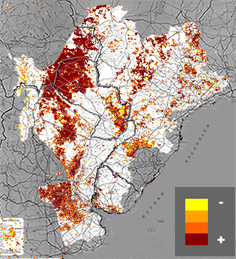Land-use change, biofuels and rural development in the La Plata Basin (2008-2011)
2008 – 2011
Funded by International Development Research Centre (IDRC)
Grant: CAD 449,530
Project activities started in March 2008 and were planned to end in September 2010. However, after the workplan was amended the project extended into 2011.
 The map shows the overlapping of four NDVI (Normalized Difference Vegetation Index) variables in La Plata Basin. The color code indicates the importance of the detected changes, from yellow (less important) to brown (more important). White areas represent areas with no significant changes. This map was filtered with a 2×2 majority kernel. Modified from http://lechusa.unsl.edu.ar/?view=hotspots
The map shows the overlapping of four NDVI (Normalized Difference Vegetation Index) variables in La Plata Basin. The color code indicates the importance of the detected changes, from yellow (less important) to brown (more important). White areas represent areas with no significant changes. This map was filtered with a 2×2 majority kernel. Modified from http://lechusa.unsl.edu.ar/?view=hotspots
The La Plata Basin (LPB) is the epicenter of agriculture and ranching in South America. Managed agricultural ecosystems in the basin play a central role in world food production and food security, and are a major source of foreign currency for the countries of the basin. In recent years the basin has experienced land cover and land use conversions at an unprecedented rate and scale. The main trend is the conversion of pasture lands and natural vegetation to arable agriculture. In 2006 the area cropped to soybean and soybean rotations reached 32 million hectares, much of it on former extensive pasture lands. As a result of this expansion and of improved technologies, the region has seen large increases in crop production and is poised to see further growth, but concerns are increasing about the environmental consequences and the resilience of current production systems. The growing tension between multiple and conflicting objectives, coupled with incomplete and uncertain information about valid societal concerns offer opportunities for salient scientific knowledge about complex agro-ecosystems to inform decision-making and policy.
Objective
The project goal is to provide guidance to actors and decision makers in the processes of rural development and landuse change. The dynamic interactions between natural and human components of agroecosystems in the LPB are being analyzed to permit the exploration of opportunities offered by increasing global demand for agricultural commodities and biofuels, while minimizing negative impacts of agricultural expansion and intensification, particularly under the risks and opportunities created by climate change. The project links the sciences of climate, landuse and rural socio-economics to:
* conduct research on, document and analyze land-use change in the context of regional climate variations over the past 25 years;
* analyze the social and economic drivers and impacts of this land use change;
* set this research in the context of rural development and markets for industrial crops and biofuels using socio-economic analyses;
* synthesize this knowledge, identify connections between climate, landuse and development patterns, and forecast trends in cooperation with and for the benefit of land users and decision makers;
* provide a gap analysis on institutional, scientific and outreach needs to guide future research and monitoring in the region; and
* strengthen institutional capacities to conduct international, interdisciplinary research and monitoring on landuse change, renewable energy, climate change, and the risks and opportunities for regional rural development.
Specific objectives
* To assess the risks and opportunities associated with climate variation and change as they affect rural development, landuse and regional hydrology;
* To assess the links between environmental, economic and social changes in rural development under changeable climate;
* To synthesize and share information to guide decision processes, developing new communication and participation channels among local actors in research and production environments, and developing the networking needed for monitoring of sustainable development and guidance of decision processes;
* To build capacity in participative methods and integrate scientific and local knowledge in the social and natural realms. Provide ground-truthing of remotely sensed and climate information by local actors and communities participating in social and economic assessments;
* To reinforce and expand an interdisciplinary, multi-institutional, five-country (Argentina, Bolivia, Brazil, Paraguay, Uruguay) research network to address the complex interactions between crop production, land use change, rural livelihoods and development, biodiversity, land quality and the key ecosystem service of hydrological regulation which is particularly important in the flood-prone LPB.
* The project will strengthen collaborative networks integrating scientists, policy makers, NGOs, producers and other stakeholders to address current and future information needs. The activities will lay the foundation for an effective research, monitoring and communication agenda for the LPB to facilitate informed decision making in one of world’s most important developing agricultural regions.
Project reports
(provided by the project investigators)
Blue-Green Municipalities: Economic analysis of selected counties in São Paulo State. M.Victoria Ramos Ballester (in English)
The Impact of Land Cover and Land Use Changes on the Hydroclimate of the La Plata Basin. Hugo Berbery (in English)
Land use change, biofuels and impacts on soil carbon dynamics in the La Plata Basin. Heitor Coutinho (in English)
Crop water relations, bioenergy options and ecosystem services in the La Plata Basin. Esteban Jobbagy (in English)
LUC Monitoring and Dynamics in the La Plata River Basin Using Remote Sensing: Methodology Development. Margareth Meirelles (in English)
Economic analysis of floods in the West of the province of Buenos Aires (Argentina). Tamara von Bernard (in Spanish)
Introduction to Agent-Based Modeling
Agent Based Models (ABM): definition, scope and limitations Carolina Cardoso, Federico Bert, Guillermo Podestá (in Spanish)
Reference list on agent-based modelling
Links to M.Sc. theses developed in the project
Clasadonte L (2008), Network companies, another way of thinking agriculture. A supply chain management vision in South America. Master Thesis, Wageningen University, 130 pp.
Moreira, IJM (2009), Transformações na pecuária mista na região de basalto do Uruguai: uma análise comparativa entre 1994 e 2008. Master thesis, Porto Alegre, 119 pp.
